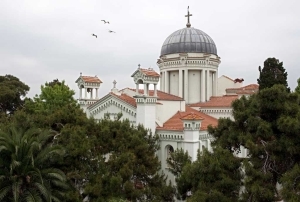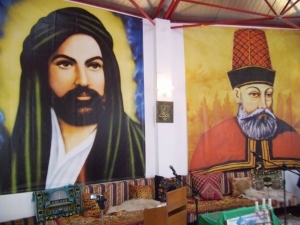Burgazada - Center
- Details
- Created on 18 February 2013
- Last Updated on 11 April 2013
The İskele
 The iskele for the sea bus is a short distance to the north of the regular ferry landing on the northeast coast of the island. There are several cafes and restaurants on the seafront around the ferry landings. Faytons wait for hire beside the park between the two piers.
The iskele for the sea bus is a short distance to the north of the regular ferry landing on the northeast coast of the island. There are several cafes and restaurants on the seafront around the ferry landings. Faytons wait for hire beside the park between the two piers.
Beaches
Motorboats can be hired near the iskeles to take the visitor to pebble beaches on the south and west shores of the island. The Adalar Su Sporları (water sports) club, with an Olympic-size swimming pool, is on Molozburnu, the promontory just to the south of the ferry landing.
The Greek Orthodox Church of Hagios Ioannis Prodromos
 The Greek Orthodox church of Hagios Ioannis Prodromos, St. John the Baptist, is the most prominent monument in the village, its dome, raised on a high drum, dominating the view as seen from the ferry as one approaches the iskele. The church is a short way from the seafront on the first street to the south of the ferry landing.
The Greek Orthodox church of Hagios Ioannis Prodromos, St. John the Baptist, is the most prominent monument in the village, its dome, raised on a high drum, dominating the view as seen from the ferry as one approaches the iskele. The church is a short way from the seafront on the first street to the south of the ferry landing.
The present church, built in 1899, is believed to stand on the site of the katholikon of the Byzantine monastery of St. John. The original katholikon was probably built in the eleventh century, and parts of its structure are thought to be incorporated in the present church, which seems to retain the plan of the earlier structure. The evidence for this conclusion is presented by George Mastoropoulos in his Patriarchal Monasteries of the Princes’ Islands.
On the left side of the narthex, or vestibule, a stairway leads down to a small subterranean crypt with a vaulted ceiling. The crypt is dedicated to St. Methodios, for this is believed to be the dungeon in which he was imprisoned by Michael II, and where he remained for seven years before being released by the emperor Theophilos. Grosvenor describes the ordeal that Methodius endured before going to his final rest:
At Antigone, Theodora erected the Church of St. John the Baptist over the cave where the Confessor had been so long confined. In the renovated modern wooden [actually stone and brick] church, still the chief sanctuary of the islanders, little remains of the early edifice. Nevertheless the apse, or eastern portion, is part of the original structure.
Ayazma
A short way to the northeast of the church, on Takım Ağa Sokağı, there is a glassed-in structure housing an ayazma dedicated to St. John the Baptist. It is believed that this is part of the original structure of the Byzantine monastery attached to the church of St. John.
Mosque and Cemevi


The village mosque stands near the shore at the northern end of Gezenti Caddesi. It is a eight-sided domed structure designed by the architect Burhan Ongun and completed in 1954.
At the southern part of the village there is a Cemevi, a house of prayer used by the Alevi community.
Sait Faik Evi
At #15 Çayır Aralığı Sokağı is the Spanudis Köşkü built by Dr. Spanudis. During the years 1934-54 this was the home of the famous writer Sait Faik Abasıyanık (1906-54) and is now a museum dedicated to his memory. It is well worth a visit, to see the mementos of the writer’s life and art, as well as to get a sense of life in a traditional island summer house. Sait Faik is also commemorated by a statue in Iskele Meydani. Many of his stories are about the ordinary people of Burgaz and their way of life, so it is very fitting that he is honored here.


 History
History 